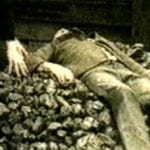 Miscellaneous
Miscellaneous  Miscellaneous
Miscellaneous  History
History 10 Huge Historical Events That Happened on Christmas Eve
 Music
Music 10 Surprising Origin Stories of Your Favorite Holiday Songs
 History
History 10 Less Than Jolly Events That Occurred on December 25
 Weird Stuff
Weird Stuff 10 Funny Ways That Researchers Overthink Christmas
 Politics
Politics 10 Political Scandals That Sent Crowds Into the Streets
 Weird Stuff
Weird Stuff Ten Bizarre Facts About The Doge Meme
 Our World
Our World 10 Ways Your Christmas Tree Is More Lit Than You Think
 Movies and TV
Movies and TV The 10 Coolest Stars to Set Sail on The Love Boat
 History
History 10 Things You Didn’t Know About the American National Anthem
 Miscellaneous
Miscellaneous Top 10 Things Crypto Was Supposed to Change & What Actually Did
 History
History 10 Huge Historical Events That Happened on Christmas Eve
 Music
Music 10 Surprising Origin Stories of Your Favorite Holiday Songs
Who's Behind Listverse?

Jamie Frater
Head Editor
Jamie founded Listverse due to an insatiable desire to share fascinating, obscure, and bizarre facts. He has been a guest speaker on numerous national radio and television stations and is a five time published author.
More About Us History
History 10 Less Than Jolly Events That Occurred on December 25
 Weird Stuff
Weird Stuff 10 Funny Ways That Researchers Overthink Christmas
 Politics
Politics 10 Political Scandals That Sent Crowds Into the Streets
 Weird Stuff
Weird Stuff Ten Bizarre Facts About The Doge Meme
 Our World
Our World 10 Ways Your Christmas Tree Is More Lit Than You Think
 Movies and TV
Movies and TV The 10 Coolest Stars to Set Sail on The Love Boat
 History
History 10 Things You Didn’t Know About the American National Anthem
10 Chilling Unsolved Mysteries From Michigan
The mystery of union big shot Jimmy Hoffa’s disappearance is arguably one of the most famous in the US. Numerous places in Michigan and other states have been searched for his body. However, there are plenty of other compelling mysteries that have happened in the Mitten State, some of them supernatural and others just as earthly.
10 The Murder Of Donald Goines And Shirley Sailor
In a career that spanned only the first four years of the 1970s, Detroit-born author Donald Goines pumped out over 16 novels, nearly all of them following criminal characters in the underground world of African-American ghettos. Like the antiheroes in his novels, Goines lived a wild and tragic life.
After he dropped out of school in the ninth grade, Goines joined the US Air Force during the Korean War by lying about his age. Following an honorable discharge when he was 17 years old, Goines fell into drug addiction and street crime.
In 1969, after almost 10 years of going in and out of jail for a number of crimes, Goines decided to straighten out his life and become a writer. While serving time for attempted larceny, Goines wrote his debut novel, Whoreson, and sent it to a publisher. The novel was accepted.
After his release from jail, Goines stopped committing other crimes, but he still had a terrible heroin addiction. His addiction became so expensive that he tried to support it with his writing. But he could only find the energy to write when he was high. Still, Goines was such a prolific writer that his publisher decided to publish a few of his novels under a pseudonym.
On October 22, 1974, the authorities received an anonymous call that Goines and his common-law wife, Shirley Sailor, were dead. When the police showed up at Goines’s house in Highland Park, a small city within Detroit, they found that Goines had been shot to death in his living room. Sailor’s body was discovered in the kitchen.
Miraculously, Goines’s two young children were found alive in the basement, either hidden there by their father or spared by the murderer. Apparently, nobody in the neighborhood had heard the murders take place, and investigators were unable to determine how many killers had been involved.
Despite Goines’s notoriety, his murder has never been solved. Some suggest that he might have been killed over a drug debt. Others believe that Goines had upset somebody with his novels, some of which contained thinly veiled depictions of real criminals whom he had known or worked with in the past.
9 The March 1966 UFO Wave
On March 20, 1966, truck driver Frank Mannor saw a pyramid-like object land in a swamp near his farmhouse in Dexter Township. When Mannor and his teenage son, Ron, went to investigate, they found the mysterious object flashing red and white lights.
Two police officers were sent to check out the UFO, but the object took off into the sky after they found it. The officers called for help and were eventually joined by 40 other policemen and some local volunteers.
While combing through the swamp, several members of the search party saw flashing bright lights in the sky. One policeman also saw a bluish UFO fly over his patrol car. The first UFO was followed by three other UFOs flying in formation.
Over the next few days, reports of UFOs and mysterious flashing lights were recorded across the state. After the sightings attracted the attention of Congressman Weston Vivian, astronomer and UFO investigator Dr. J. Allen Hynek was sent to Michigan by the US Air Force to find an explanation.
On March 25, after two days of questioning witnesses, Hynek told reporters at a Detroit conference that the sightings in places like Dexter Township and Ann Arbor were probably misidentifications of swamp gas.
Although University of Michigan professors had offered the same theory days earlier, Hynek’s hasty conclusion caused public outrage. Newspapers screamed that a cover-up was taking place, and Congressman Gerald Ford asked that Congress organize an investigation.
Although the causes of most of those UFO sightings might have been earthly in origin, soil samples from the area where the Mannons had spotted their UFO showed radiation levels that were higher than normal. These results, which also found high levels of radiation in the water, have never been explained.
8 The Murder Of Chelsea Bruck
On October 26, 2014, 22-year-old Chelsea Bruck drove with a friend to a Halloween party in Frenchtown Township. Bruck was dressed like the Batman villain Poison Ivy, and many of the other partygoers had also shown up in costumes.
The party, which had been publicized on social media sites, attracted more than 700 people from Michigan and other states. At around 3:00 AM, Bruck was spotted walking outside with a dark-haired man who had a light mustache and wore black-framed glasses. It was the last time that anyone would see her alive.
Over the next few days, investigators and volunteers searched the area for Bruck but to no avail. To raise awareness of Bruck’s disappearance, purple ribbons were hung across the town and one million missing person posters were distributed around the country.
Despite all this help, the official investigation was difficult. With so many unfamiliar people at the Halloween party, disguised in costumes to boot, nobody could identify the mysterious man who had left with Bruck.
On April 5, 2015, Bruck’s costume was found at an abandoned construction site several miles away from where she disappeared. Her body was found in a nearby field nearly three weeks later.
Although information about the cause of Bruck’s death hasn’t been released to the public, the authorities are investigating her death as a homicide. After 34 search warrants and hundreds of interviews, Chelsea Bruck’s killer remains unidentified and on the loose.
7 The Disappearance Of Connie Converse

Years before singer-songwriters like Bob Dylan and Joan Baez revolutionized folk music by playing highly personal songs on acoustic guitars, Connie Converse was doing the same thing in New York City’s Greenwich Village during the 1950s.
Unlike those two famous singers, however, Converse’s career never took off. She only played at bars and parties and never recorded an album. In fact, her only recordings were done on a tape recorder in a music enthusiast’s kitchen.
After years of trying to make it as a singer, Converse gave up in 1961 and moved to Ann Arbor, Michigan, to be with her family. Although she worked as a secretary and later edited an academic journal, Converse fell into a depression and took to heavy drinking and smoking.
In summer 1974, Converse suddenly packed up her things and left Michigan. She never told anybody where she was going, but she did send letters to her friends and family to tell them that she was leaving.
When years passed without any further contact, her family began to fear the worst. In the 1980s, Converse’s brother hired a private investigator to look for her, but the detective was unable to come up with anything.
Due to her issues with depression, her family suspects that Converse might have committed suicide. Even if she didn’t take her own life, her habits of heavy drinking and smoking make it quite unlikely that Converse is alive today.
In 2004, a music producer rediscovered Converse’s amateur recordings and released them on CD. Converse has since developed a cult following, achieving at last the success that she sought over 50 years ago.
6 The Murder Of Nevaeh Buchanan
On May 24, 2009, five-year-old Nevaeh Buchanan went to play at a neighbor’s place in an apartment complex in Monroe County. Although her mother, Jennifer, had told her to stay in the friend’s apartment, Nevaeh decided to ride her tricycle outside. When Jennifer found out and went outside to fetch her daughter, Nevaeh didn’t appear to be in the complex. Only her tricycle was found.
Nearly two weeks passed before Nevaeh’s body was found by a fisherman and his son along a river 16 kilometers (10 mi) away. Nevaeh had been buried in a shallow grave, hidden under a block of concrete. It’s believed that she was buried alive and died after suffocating on dirt. Her autopsy found no signs of sexual assault or drugs in her system.
Although no one has been charged in Nevaeh’s abduction and murder, investigators did show some early interest in two of Jennifer Buchanan’s friends. Both men are known sex offenders. They were taken into custody and questioned after Nevaeh’s disappearance.
One of the men, George Kennedy, was apparently close with Nevaeh and had been nicknamed “Daddy George.” Kennedy lived in a motel near Nevaeh’s apartment, and his job involved working with concrete. Neither Kennedy nor the other man were considered credible suspects, however, and were eventually let go.
As of March 2016, the authorities are offering a reward of $50,000 to anybody who can provide the breakthrough tip they need to find and convict Nevaeh’s killer.
5 Melon Heads

The Melon Heads are a group of small cannibals with unusually large heads who are said to roam certain forests in Michigan’s Lower Peninsula. According to the most common legend, the Melon Heads were once children who suffered from hydrocephalus, a medical condition causing an excessive amount of liquid around the brain that may enlarge a person’s head.
The local lore of Allegan County suggests that some hydrocephalic children were confined to the Junction Insane Asylum after World War II. There, researchers subjected the children to cruel medical experiments to try to relieve their condition.
Nothing worked, however, and the children grew into mentally deficient mutants. After the asylum was closed, the deformed children were either released or escaped into the woods. Since then, they have lived around the ruins of the asylum. They interbreed with one another and attack and eat any normal people who wander into their territory.
Specifically, the ruins are said to be located on the property of the Felt Mansion, a building which was once used as a Catholic seminary school and later a prison. Despite reports of late-night visitors claiming to hear strange noises and see small silhouettes in the area, the Allegan County Historical Society has reported that Junction Insane Asylum never existed.
In fact, the legend of the Melon Heads might have originated when the Felt Mansion was known as the St. Augustine Seminary. The students there were taunted by some locals as “melon heads” because the school was private. Other locals disliked the place due to religious differences.
Still, the legend of the Melon Heads persists. Allegedly, they can also be found in Ohio and Connecticut.
4 The John Doe Of Plymouth Township

On May 10, 1997, a man surveying a wooded area in Plymouth Township noticed a mouse scamper into a rolled-up carpet. When the surveyor lifted the carpet to try to catch the mouse, he stumbled upon a human skeleton on the ground beneath the carpet.
The skeleton was later determined to have belonged to an adult white male between the ages of 35 and 50. He was dressed in a blue-and-white striped shirt, blue shorts, and socks that referenced the 1980 Olympics.
After conducting medical examinations and DNA tests, the authorities concluded that the mystery man had been killed by a heavy blow to the head. He had a strong build but seemed in poor health. He wore dentures and also had a fake gold ring on his finger.
Interestingly, he might have had a military background. His upper right arm, which was fractured, held a kind of surgical pin commonly used in military field hospitals. Although the date of death wasn’t certain, the carpet that had covered the man dated to the 1970s.
In August 2015, there seemed to be a promising new lead when the authorities were notified about the 1991 murder of a man named Gustav Prilepok in nearby West Bloomfield Township. Prilepok, a welder with a military background, had been killed by his wife, Janea, and his stepson, Jan Borek, after getting into an argument with them.
Initially, they reported Prilepok missing and hid his body in either a roll of carpet or linoleum. Although Borek and Janea eventually confessed to Prilepok’s murder, his body was never recovered.
However, Plymouth Township police are skeptical that the remains from the woods belong to Gustav Prilepok. He didn’t wear dentures, and his waist is believed to have been larger than that of the man found in the carpet. Borek and Janea have long since been deported, taking the secret of their victim’s whereabouts with them.
3 The Murder Of David Widlak
On the morning of September 20, 2010, a maintenance worker for the Community Central Bank in Mount Clemens, Michigan, found the empty car of company CEO David Widlak in the parking lot. Widlak wasn’t anywhere in the building, either. So the worker called the police after finding Widlak’s office in complete disarray.
As it turned out, Widlak had not been seen since leaving work the previous night. According to security footage, he had left the building around 8:00 PM. He was seen waiting at the door for 26 seconds and then walking out by himself. Although they acknowledged that Widlak might have disappeared voluntarily, the authorities declared him a missing person.
By early October, there were still no signs of David Widlak. Investigators feared that the banker might have been the victim of foul play. For whatever reason, Widlak had bought a semiautomatic handgun several weeks before he went missing.
Whether Widlak bought it for self-defense or because he felt suicidal has never been established. While he normally kept it in his office, the gun disappeared with him.
After almost one month of searching, Widlak’s decomposed body was found floating in a lake 6 kilometers (4 mi) away from his bank. Noting that there were no signs of injuries on Widlak’s body, the medical examiner concluded that Widlak had committed suicide.
However, Widlak’s family was skeptical and arranged a second autopsy. Amazingly, the first autopsy had missed a bullet that was found in Widlak’s neck. He had been shot execution style in the back of the head, and investigators discovered his missing gun in the area where his body was found.
Relatives accused the first coroner of a cover-up, but the coroner claimed that he had misread the X-ray results. Investigators have since reclassified Widlak’s case as an unsolved homicide, but they have had few leads.
Reportedly, Widlak was looking for new investors before his disappearance, leading some to suggest that his murder might have been connected to a potential business deal.
2 The Dogman
The Dogman, a cryptid variously described as a large dog that can stand upright or a dogheaded creature with a human body, has allegedly been spotted in the northern parts of Michigan’s Lower Peninsula since the late 19th century.
Dating back to 1887, the earliest encounter supposedly occurred when a group of lumberjacks in Wexford County chased the Dogman into a hollow log. Mistaking the monster for an ordinary dog, one of the men tried to get it out of the log by jabbing it with a stick. The men heard a terrible scream, and then the Dogman jumped out and scared them all away.
In 1987, a Traverse City radio DJ named Steve Cook released a ballad about the Dogman that increased the monster’s popularity. Although Cook meant for the song to be a joke, listeners called in to share their own encounters. Older stories soon surfaced as well.
One of the more interesting stories came from Robert Fortney, an elderly man who claimed to have seen a similar creature in the late 1930s. While fishing in a river near Paris, Michigan, Fortney saw a pack of wild dogs emerge from the woods. He scared off most of the pack with a warning shot from his gun.
But a large black dog with blue eyes refused to leave. In fact, the dog rose on its hind legs and gave Fortney an intimidating stare. Before it could get any closer, Fortney shot the dog and then watched it run back into the woods.
Despite the many encounters and sightings over the years, no physical evidence has ever turned up to prove that the Dogman exists. In the late 2000s, a home video containing footage of the Dogman appeared on the Internet, but this was later debunked as a hoax.
1 The Murder Of Lydia Thompson

Russian-born Lydia Thompson and her British husband, Louis, had moved from Europe to the US after World War I. Settling in Detroit, Louis achieved great success by running a car dealership. The Thompsons became rich, and Louis was able to open up a laundromat for his wife to manage.
After more than 20 years of marriage, however, the Thompsons began to drift apart. Lydia feared that Louis was having an affair. After hiring some detectives to follow her husband, Lydia discovered that Louis had been seeing a secretary named Helen Budnik. Despite Lydia’s attempt to repair her marriage, Louis eventually moved out of the house and decided that he would divorce her.
On October 13, 1945, Lydia Thompson’s headless body was discovered in a marsh near Pontiac, Michigan, by some mushroom pickers. She had been tortured and stabbed with an ice pick.
Although investigators immediately suspected Louis and his mistress, both passed a lie detector test and had strong alibis around the time of Lydia’s murder. After more than one year of investigating weak leads, the authorities decided to arrest and charge Louis and his mistress after all.
While there was little evidence to convict Louis and Helen, an apparent breakthrough came when a woman came forward and said that her boyfriend had confessed to Lydia’s murder. According to the story, Louis had paid the man $10,000 to kill his wife.
In reality, however, the man was married and had concocted the confession to frighten away his girlfriend. Louis and Helen were released, and the murder remains a mystery. While some believed that the couple was guilty, another theory suggested that Lydia might have been murdered by one of the many detectives whom she had hired to spy on her husband.
In the months leading up to her death, Lydia had been behaving strangely. She had purchased a gun and told friends that she was being followed. But they dismissed her fear as paranoia.
In addition, Lydia had borrowed $7,000 from her husband during the year despite being financially secure from her earnings at the laundromat. Investigators never figured out where the money went. It’s believed that Lydia may have used it to pay for detectives, but one rumor also claimed that she used it to put a hit on Helen Budnik.
Tristan Shaw runs a blog called Bizarre and Grotesque, where he writes about unsolved mysteries, paranormal phenomena, and other creepy and weird things.








